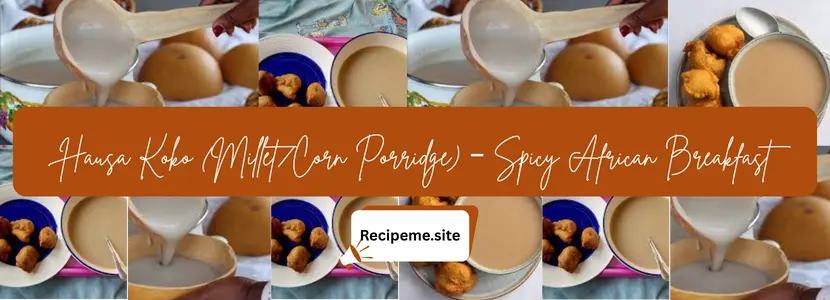
Introduction
What’s the one breakfast that warms your body, wakes up your senses, and connects you to centuries of tradition? For many West Africans, that answer is Hausa Koko (Millet/Corn Porridge).If you’ve ever walked through the early morning streets of Accra, Lagos, or Kano, you’ve likely caught the unmistakable aroma of freshly made koko—spicy, tangy, and utterly comforting. It’s often sold by roadside vendors, served hot in steaming bowls with accompaniments like koose (bean cakes) or akara.
Growing up, many people recall koko as a “school morning breakfast”—the quick, nourishing meal eaten before rushing off to start the day. The moment that first spoonful hits your mouth, with its subtle sourness and warm ginger kick, you realize it’s not just porridge. It’s heritage in a bowl.
History of Hausa Koko
The name “Hausa Koko” originates from the Hausa ethnic group of northern Nigeria, though the dish is equally popular in Ghana and across West Africa. Traditionally made with fermented millet or corn flour, koko has been a staple food for centuries.
The fermentation process, passed down through generations, gives koko its slightly sour taste while boosting its nutritional value. Early Hausa communities often enjoyed it as a hearty breakfast before heading to the farms or markets. Over time, koko spread across West Africa, adapting slightly in flavor depending on local spices and preferences.
Did You Know? Fermentation not only enhances koko’s flavor but also improves digestibility and increases the availability of essential minerals like iron and zinc.
Essential Ingredients
The magic of Hausa Koko lies in its simple yet flavorful base:
-
Millet or Corn Flour (fermented for authentic taste)
-
Ginger (for warmth and aroma)
-
Cloves (adds depth and spice)
-
Black Pepper or Chili (for heat)
-
Salt (to balance flavors)
-
Water (to cook into a smooth porridge)
Optional additions:
-
Sugar or Honey (for sweetness, though many prefer it plain)
-
Nutmeg (for extra fragrance)
-
Milk or Evaporated Milk (modern twist, especially in urban areas)
Variations of Hausa Koko
While the foundation is the same, Hausa Koko comes in several delicious variations:
-
Traditional Hausa Koko (Nigeria): Stronger spice blend with cloves, ginger, and chili.
-
Ghanaian Koko: Slightly lighter and usually enjoyed with koose or bread.
-
Sweetened Koko: Served with sugar, honey, or milk for children and those who prefer a milder version.
-
Corn Koko: Made with fermented corn flour instead of millet for a smoother texture.
Preparation: Step-by-Step Guide
Here’s how to prepare authentic Hausa Koko at home.
Ingredients (Serves 4)
-
2 cups fermented millet (or corn) flour
-
1½ liters water
-
1 teaspoon ground ginger
-
½ teaspoon ground cloves
-
1 teaspoon chili powder or black pepper
-
Pinch of salt
-
Sugar or honey (optional)
Instructions
-
Mix the Flour
-
In a bowl, mix the fermented millet flour with a little cold water to form a smooth paste (no lumps).
-
-
Boil Spices
-
In a pot, bring water to a boil. Add ginger, cloves, and chili. Allow to simmer for 3–5 minutes.
-
-
Cook the Porridge
-
Gradually pour the flour paste into the boiling water while stirring continuously to avoid lumps.
-
-
Simmer and Stir
-
Cook on low heat for 10–12 minutes, stirring frequently until thick and smooth.
-
-
Sweeten (Optional)
-
Add sugar, honey, or milk if desired.
-
-
Serve Hot
-
Pour into bowls and enjoy with koose, akara, bread, or groundnuts.
-
Pro Tip: Always stir vigorously when adding the flour paste to boiling water. This prevents lumps and ensures a smooth, creamy koko.
Cultural Significance
Hausa Koko is not just food—it’s a cultural anchor.
-
In Ghana, koko is the most popular street breakfast, sold by vendors at dawn and enjoyed with bean cakes.
-
Among the Hausa in Nigeria, koko is often consumed with masa (rice cakes) or fried bean balls.
-
Across West Africa, koko is regarded as a comfort food, nourishing both body and spirit, especially on chilly mornings.
Beyond daily life, koko also plays a role in hospitality—guests are often welcomed with a warm bowl as a gesture of kindness.
Serving Suggestions
Hausa Koko can be paired with many side dishes to make it even more enjoyable:
-
Koose/Akara (bean cakes)
-
Bofrot (puff-puff)
-
Bread rolls or buttered bread
-
Groundnuts (peanuts)
-
Masa (rice cakes)
Types of Hausa Koko
-
Millet Koko – Traditional, with a stronger flavor.
-
Corn Koko – Smoother and slightly sweeter.
-
Spicy Koko – With extra ginger, cloves, and chili for a fiery kick.
-
Sweetened Koko – Lightly flavored with milk and sugar, often given to children.
Tips for Perfect Hausa Koko
-
Use fermented flour for authentic flavor.
-
Adjust spices to your taste—ginger for warmth, cloves for depth, chili for heat.
-
Stir continuously while cooking to avoid lumps.
-
Serve immediately while hot; koko thickens as it cools.
-
For meal prep, freeze the flour paste in small portions for quick cooking.
Other Valuable Information
-
Health Benefits: Millet-based koko is high in fiber, iron, magnesium, and B-vitamins, making it great for digestion and energy.
-
Hidden Fact: Traditionally, koko vendors in Ghana are so popular that some families never cook koko at home—they buy it fresh every morning.
-
Expert Insight: Nutritionists often recommend koko as a gluten-free breakfast option for people with wheat intolerance.
Personal Experience: My Journey with Hausa Koko
The first time I tried Hausa Koko was at a roadside stall in Accra. The vendor poured steaming koko into a bowl, served alongside a crisp koose. The tangy, spicy flavor was unlike any porridge I’d ever had.
Since then, I’ve tried making it at home, tweaking the spice levels to my liking. Each time I stir the bubbling pot, I’m reminded of that busy Accra morning, where laughter, traffic, and the smell of koko filled the air. For me, this dish is not just breakfast—it’s a reminder that the simplest foods often carry the richest stories.
Conclusion
Hausa Koko (Millet/Corn Porridge) is more than a breakfast—it’s a cultural tradition, a comfort food, and a healthy way to start the day. From the Hausa kitchens of northern Nigeria to the bustling streets of Ghana, koko continues to nourish and unite communities.
So the next time you’re craving something warm, spicy, and satisfying, why not try a bowl of koko? You won’t just be eating porridge—you’ll be tasting history.
Frequently Asked Questions (FAQs)
1. What is Hausa Koko made of?
It is made from fermented millet or corn flour, spiced with ginger, cloves, chili, and sometimes sweetened with sugar or honey.
2. Is Hausa Koko healthy?
Yes! It’s rich in fiber, vitamins, and minerals. Millet-based koko is gluten-free and supports digestion and energy levels.
3. Can Hausa Koko be made without fermentation?
Yes, but the flavor changes. Fermentation gives it the authentic tangy taste. Without it, the porridge will be milder.
4. How do you store Hausa Koko?
Koko is best eaten fresh, but the flour paste can be refrigerated for up to 5 days or frozen for longer storage.
5. What do you eat with Hausa Koko?
It is commonly served with koose, akara, bread, bofrot, or masa.
6. Is Hausa Koko only for breakfast?
Traditionally it’s a breakfast meal, but many enjoy it as a light dinner or snack.
